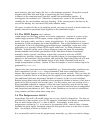
FREQ Syntax: FREQ <frequency in Hz>
LAMBDA Syntax: LAMBDA <wavelength in metres>
Specify the frequency or free-space wavelength of the excitation
sources (all will be the same). FREQ is an alternative to
LAMBDA—use one or the other, but not both.
Examples:
FREQ 200*THz
FREQ c/(1.464*700*nm) /* 700 nm in fused SiO
2
*/
LAMBDA 1.55*micron /* Communication wavelength */
LAMBDA 6.328e-7 /* He-Ne laser */
FUNCTION Define a user math function. User functions can be anything REXX
can evaluate, plus elementary functions (sin, cos, tan, asin, acos,
atan, atan2, exp, ln), Bessel functions of the first kind of integer
order (Jn(x)), complete elliptic integrals, and a few other odds and
ends. Once defined, a user function can be used freely in
expressions anywhere a literal number or a variable could.
Functions may be defined in terms of variables, literals, or other
functions, subject to the file parsing rules. When optimization is
enabled, functions whose output values depend on variables being
optimized over will have their definitions updated on each iteration
to reflect the new values of these variables.
If the name of a formal parameter of the function is the same as
that of a user variable, the formal parameter will override the user
variable inside the function. Otherwise, any variables used by the
function will be taken from the global scope. This allows functions
to be parameterized by other variables, e.g. scale factors or offsets,
which are not in the formal parameter list.
Syntax:
FUNCTION name(arg1, arg2,..., argN) = <expression>
Examples:
FUNCTION myfunc(a,x,q)=exp(a)*atan(q/x)*sqrt(23+q)
FUNCTION parab(x,y,focus)=(x*x+y*y)/(4*focus)
FUNCTION cone(x,y)=sqrt(parab(x,y,1)
HOSTS Specifies a file containing TCP/IP information on the hosts available
to run the current simulation.
Syntax: HOSTS <hostfile>
where entries in the given file are of the form
11


















